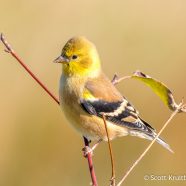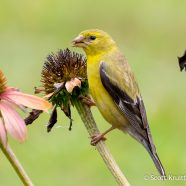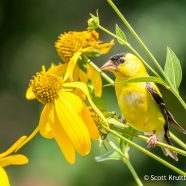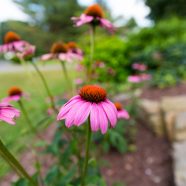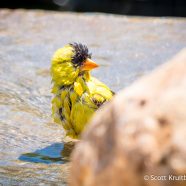American Goldfinch
The summer shades may have worn away but there is still an awful lot to like about this American Goldfinch (Spinus tristis). This November bird is one of many we can enjoy even as the rest of the colors begin to fade around us. They can be one of the more confusing species to some people who see them at their feeders this time of year owing to the variability in their molt, even if those birders have their handy Peterson Field Guide. The finch’s dull and patchy winter look may seem strange as it is such a shift from their glowing gold.
Read MoreAmerican Goldfinch Eating Coneflowers
Finally! It took me a while, but here is photographic proof of why you should not cut any dead coneflower heads. This American Goldfinch was chowing down and enjoying it so much that it ignored me. I frequently hear and occasionally see them dining like this, but never when my camera is near or I am close to them. Many plants end up producing delicious seeds in their…less aesthetically pleasing stages…and should be left alone as a meal for many forms of wildlife, or even just to propagate their species. Scott Kruitbosch Conservation & Outreach Coordinator
Read MoreAmerican Goldfinch on Cutleaf Coneflower
This American Goldfinch (Spinus tristis) posed so delightfully for a split second while dining on this Cutleaf Coneflower (Rudbeckia laciniata)…and we wonder why they are gold…what perfection.
Read MoreConeflower Seeds
Here is where I would be posting a photo of a gorgeous American Goldfinch feeding on the seed heads of mature Eastern Purple Coneflowers, but sadly whenever I am outdoors I either flush the birds unintentionally first, or I get to watch them without a camera in my hand. Fingers crossed for the future…but you should leave your coneflowers be and resist pruning them even when they are wilting and getting “ugly” so that the birds can enjoy a seed feast in the late summer and fall. Scott Kruitbosch Conservation & Outreach Coordinator
Read MoreAmerican Goldfinch Bath
It must feel splendid to take a warm bath in the summertime as opposed to trying to clean the feathers in the ice and snow all winter long. Go you, American Goldfinch (Spinus tristis)! Soak it up!
Read More



